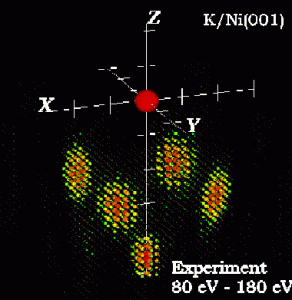Reconstruction of Atomic Adsorption Sites
by
Holographic LEED
The 3D perspective image of a potassium adsorbate on a nickel (001) surface (K/Ni(001)), shown above, was calculated by a holographic reconstruction algorithm from a set of simulated diffuse LEED patterns where the K atoms were taken to be adsorbed in four-fold hollow sites on the Ni(001) surface. The artificial red sphere at the origin of the coordinate system was placed there to represent the potassium adsorbate atom. The holographic reconstruction data shows the surface data in relation to the adsorbate atom in a bubble format where the size and color intensity of the spheres combine to give a density mapping of the most likely positions of the Ni atoms. Looking at the figure, the positions of the 4 symmetric nearest-neighbor Ni atoms in the top surface layer below the K atom can be discerned as can the position of the Ni atom directly below the K atom in the second surface layer. The algorithm employed here is described in the paper by D. K. Saldin and X. Chen, Phys. Rev. B 52, 2941 (1995).
This 3D perspective image was reconstructed using the same holographic computer algorithm as the above with data measured from a set of experimental diffuse LEED patterns for the same K/Ni(001) surface. The experimental data were measured by the research group headed by Prof. K. Heinz of the University of Erlangen-Nuernberg, Germany. The same information can be discerned as to the positions of the neighboring Ni atoms in the surface beneath the K adsorbate atom. See the paper by D. K. Saldin, K. Reuter, P. L. De Andres, H. Wedler, X. Chen, J. B. Pendry, and K. Heinz, Phys. Rev. B 54, 8172 (1996).

